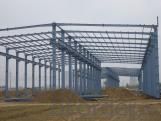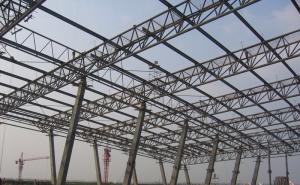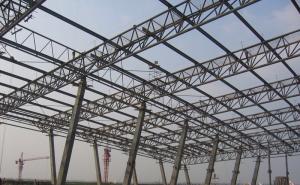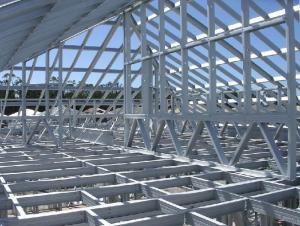Grid Frame Structure Steel Structure
- Loading Port:
- China Main Port
- Payment Terms:
- TT or LC
- Min Order Qty:
- -
- Supply Capability:
- -
OKorder Service Pledge
OKorder Financial Service
You Might Also Like
OKorder is offering Grid frame structure steel structure at great prices with worldwide shipping. Our supplier is a world-class manufacturer of steel, with our products utilized the world over. OKorder annually supplies products to European, North American and Asian markets. We provide quotations within 24 hours of receiving an inquiry and guarantee competitive prices.
Product Applications:
Grid frame structure steel structure are ideal for structural applications and are widely used in the construction of buildings and bridges, and the manufacturing, petrochemical, and transportation industries.
Product Advantages:
Grid frame structure steel structure are durable, strong, and resist corrosion.
Main Product Features:
· Premium quality
· Prompt delivery & seaworthy packing (30 days after receiving deposit)
· Corrosion resistance
· Professional Service
· Competitive pricing
Product Specifications:
Specifications
1) . Easy to install, fire proof, good insulation
2). Certification: ISO9001:2000, SGS Standard.
Steel Structure Warehouse:
1.The steel structure of the connection method: welding connection
2.Steel structure design common norms are as follows: "Steel Design Code" (GB50017-2003) Cold-formed steel structure technical specifications" (GB50018-2002) "Construction Quality Acceptance of Steel" (GB50205-2001) "Technical Specification for welded steel structure" (JGJ81-2002, J218-2002) "Technical Specification for Steel Structures of Tall Buildings" (JGJ99-98)
3.The characteristics of steel Light weight steel structure Higher reliability of steel work Steel anti-vibration (earthquake), impact and good Steel structure for a higher degree of industrialization Steel can be assembled quickly and accurately Large steel interior space Likely to cause sealing structure Steel corrosive Poor fire-resistant steel Recyclable steel shorter duration
4.Commonly used steel grades and performance of steel Carbon
structural steel: Q195, Q215, Q235, Q255, Q275, etc.
High-strength low-alloy structural steel Quality carbon structural steel and alloy structural steel Special purpose steel Product Feature Carport, House, Office, Shop, Toilet, Villa, Warehouse, Workshop, Plant Other Information
Products have been all over the country more than 20 provinces, municipalities and autonomous regions, and have been exported to Europe, North America, the Middle East, Africa, Asia and other countries and regions, the widespread use
FAQ:
Q1: Why buy Materials & Equipment from OKorder.com?
A1: All products offered byOKorder.com are carefully selected from China's most reliable manufacturing enterprises. Through its ISO certifications, OKorder.com adheres to the highest standards and a commitment to supply chain safety and customer satisfaction.
Q2: How do we guarantee the quality of our products?
A2: We have established an advanced quality management system which conducts strict quality tests at every step, from raw materials to the final product. At the same time, we provide extensive follow-up service assurances as required.
Q3: How soon can we receive the product after purchase?
A3: Within three days of placing an order, we will begin production. The specific shipping date is dependent upon international and government factors, but is typically 7 to 10 workdays.
Images:


- Q:Can steel structures be designed with outdoor seating areas?
- Yes, steel structures can be designed with outdoor seating areas. Steel is a versatile material that offers strength, durability, and flexibility in design. With proper engineering and construction techniques, steel structures can incorporate outdoor seating areas, such as balconies, terraces, or open-air decks, providing comfortable and functional spaces for people to enjoy the outdoors.
- Q:What does "fixation" mean in steel structures?
- The solid connection is the rigid connection, which completely limits the relative displacement and the rotation angle of the two members at that point. The rigid joint can transfer the axial force, the lateral force and the bending moment to each other.
- Q:How does corrosion affect steel structures and how can it be prevented?
- The environment causes corrosion, a natural process that damages steel structures, especially with moisture and oxygen. This corrosion weakens and thins the steel, making it more susceptible to deformation and failure. In severe cases, it can even cause structural collapse. To protect steel structures from corrosion, several measures can be taken. The first step is applying a protective coating like paint or galvanizing, which acts as a barrier against moisture and oxygen. Regular maintenance and inspection are also important to detect and address any signs of rust or deterioration promptly. Proper drainage and ventilation systems should be in place to minimize moisture accumulation. Cathodic protection is another effective measure, using sacrificial anodes or impressed current systems to divert corrosion away from the steel. These anodes corrode instead, protecting the steel. In construction projects where corrosion is a major concern, corrosion-resistant alloys or stainless steel can be considered to prolong the lifespan of steel structures. In summary, preventing corrosion in steel structures involves proactive measures like protective coatings, regular maintenance, drainage systems, and the use of corrosion-resistant materials. Implementing these strategies greatly enhances the lifespan and safety of steel structures.
- Q:How do steel structures handle torsional forces?
- Steel structures handle torsional forces by incorporating additional elements and design features to resist twisting. These elements may include diagonal bracing, cross bracing, shear walls, and moment-resisting frames. By distributing and transferring the torsional forces throughout the structure, steel buildings can effectively resist twisting and maintain their stability.
- Q:Why steel buildings have the best seismic performance?
- 1, under the same size, the steel structure has a lighter weight, and the seismic energy received in the earthquake is smaller;2, steel structure has very good ductility, each member of the moment deformation is easy to coordinate;
- Q:How are steel structures designed for cultural buildings?
- Steel structures for cultural buildings are designed with several key considerations in mind. First and foremost, the design needs to reflect the unique aesthetic and functional requirements of the cultural building. This involves studying the architectural style, form, and purpose of the building to ensure that the steel structure complements and enhances its overall design. In terms of structural integrity, steel offers immense strength and durability, making it a popular choice for cultural buildings. The design process involves analyzing the loads and stresses that the building will be subjected to, such as gravity loads, wind loads, and seismic forces. By considering these factors, engineers can determine the appropriate size, shape, and configuration of the steel members to ensure the structure's stability and safety. Flexibility is another crucial aspect of steel structure design for cultural buildings. Many cultural buildings, such as museums or art galleries, often require large open spaces and flexible layouts to accommodate changing exhibits or performances. Steel's high strength-to-weight ratio enables the creation of long-span structures with minimal columns or supports, allowing for more versatile and adaptable interior spaces. Additionally, sustainability plays an important role in the design process. Steel is a highly recyclable material, and its use can contribute to the overall sustainability goals of the cultural building. Designers strive to minimize the environmental impact by optimizing the use of steel and incorporating sustainable design strategies such as energy-efficient systems and materials. Finally, the construction process and cost-effectiveness are significant considerations. Steel structures offer excellent prefabrication opportunities, allowing for faster and more efficient construction. The ability to fabricate steel members off-site ensures precise manufacturing and reduces construction time and costs. This is particularly beneficial for cultural buildings, where time and budget constraints often play a crucial role. In summary, the design of steel structures for cultural buildings involves careful consideration of aesthetic, functional, structural, sustainability, and cost factors. By addressing these aspects, engineers and designers can create steel structures that not only meet the unique requirements of cultural buildings but also enhance their overall architectural quality and longevity.
- Q:How do steel structures perform in terms of sustainability and recyclability?
- Steel structures perform exceptionally well in terms of sustainability and recyclability. Steel is one of the most sustainable construction materials as it can be recycled indefinitely without losing its properties. The recycling process consumes less energy and produces fewer emissions compared to primary steel production. Moreover, steel structures have a long lifespan and require minimal maintenance, reducing the need for replacement and further resource consumption. Additionally, steel's strength allows for lighter and more efficient designs, reducing material usage and transportation costs. Overall, steel structures are highly sustainable and contribute significantly to the circular economy.
- Q:How are steel structures designed for seismic zones?
- Steel structures designed for seismic zones are constructed to endure the immense forces generated during an earthquake. These structures are specifically engineered to minimize the potential damage caused by seismic activity and ensure the safety of the individuals inside. The design procedure for steel structures in seismic zones entails several crucial factors. First and foremost, the selection of suitable materials is of utmost importance. Typically, high-strength steel with excellent ductility is used as it is capable of effectively absorbing and dissipating seismic energy. The steel components are also designed to possess adequate stiffness and flexibility in order to resist lateral forces and deform under seismic loads. Another significant aspect is the structural arrangement. Buildings in seismic zones are frequently designed with lateral load-resisting systems, such as moment frames, braced frames, or shear walls. These systems provide stability and distribute seismic forces throughout the structure, thereby reducing the concentration of stress on specific elements. Furthermore, the connections between steel members are meticulously designed to ensure their ability to withstand seismic forces. Special attention is given to the detailing of connections to guarantee that they possess sufficient strength, ductility, and energy dissipation capacity. Properly designed connections can enhance the overall performance of the steel structure during an earthquake. In addition to material selection and structural arrangement, engineers also take into account the site-specific conditions and ground motion characteristics. Seismic hazard assessments are conducted to determine the expected level of ground shaking in a particular area. This information aids in establishing the design parameters and ensuring that the steel structure can safely withstand the anticipated seismic forces. Computer simulations and advanced analysis techniques, such as nonlinear dynamic analysis, are frequently employed to evaluate the behavior of steel structures under seismic loads. These tools enable engineers to assess the performance of the structure, identify potential vulnerabilities, and make necessary design modifications to enhance its seismic resistance. In summary, the design of steel structures for seismic zones is a complex process that requires a thorough comprehension of the seismic forces and their impacts. By incorporating suitable materials, structural arrangements, connection designs, and site-specific considerations, engineers can create steel structures capable of enduring seismic events and safeguarding lives and property.
- Q:How are steel structures designed for corrosion protection in marine environments?
- Steel structures that are intended to be used in marine environments require specific measures and materials to ensure that they remain durable and resistant to corrosion. These measures involve the use of corrosion-resistant alloys, protective coatings, and cathodic protection systems. One commonly employed approach involves the utilization of stainless steel or other alloys that are resistant to corrosion for the construction of marine structures. These alloys contain elements such as chromium, nickel, and molybdenum, which enhance their ability to withstand corrosion caused by saltwater and high humidity. By incorporating these alloys into the structures, they can effectively resist the corrosive effects of the marine environment and maintain their structural integrity for extended periods of time. Another method of protecting against corrosion involves the application of protective coatings. These coatings act as a barrier between the steel structure and the surrounding environment, preventing direct contact with corrosive elements. Commonly used coatings in marine environments include epoxy, polyurethane, and zinc-rich paints. These coatings are specifically formulated to withstand the harsh conditions found in marine environments, such as high salinity, humidity, and exposure to sunlight. Cathodic protection systems are also utilized to safeguard steel structures in marine environments. These systems function by creating an electrical circuit that redirects the flow of electrons from the steel structure to a sacrificial anode made of a more easily corroded metal, such as zinc or aluminum. By sacrificing the anode, the steel structure is shielded from corrosion as the anode corrodes instead. This method is particularly effective in areas where the protective coating may be damaged or insufficient. In addition to these specific design measures, regular maintenance and inspections are crucial for ensuring ongoing corrosion protection of steel structures in marine environments. This includes periodic cleaning, repairing or replacing damaged coatings, and monitoring the effectiveness of cathodic protection systems. By implementing these measures, steel structures can be designed to endure the corrosive effects of marine environments, guaranteeing their longevity and safety.
- Q:How do steel structures contribute to the overall cost-effectiveness of a building?
- Steel structures contribute to the overall cost-effectiveness of a building in several ways. Firstly, steel is a highly durable material with a long lifespan, which reduces the need for frequent repairs or replacements, saving money in the long run. Additionally, steel structures are easy and quick to construct, reducing labor costs and minimizing the overall construction time. Moreover, steel is a lightweight material, enabling smaller foundations and reducing the amount of excavation required, leading to cost savings. Lastly, steel is a recyclable material, making it environmentally friendly and potentially reducing disposal costs at the end of a building's life cycle.
1. Manufacturer Overview |
|
|---|---|
| Location | |
| Year Established | |
| Annual Output Value | |
| Main Markets | |
| Company Certifications | |
2. Manufacturer Certificates |
|
|---|---|
| a) Certification Name | |
| Range | |
| Reference | |
| Validity Period | |
3. Manufacturer Capability |
|
|---|---|
| a)Trade Capacity | |
| Nearest Port | |
| Export Percentage | |
| No.of Employees in Trade Department | |
| Language Spoken: | |
| b)Factory Information | |
| Factory Size: | |
| No. of Production Lines | |
| Contract Manufacturing | |
| Product Price Range | |
Send your message to us
Grid Frame Structure Steel Structure
- Loading Port:
- China Main Port
- Payment Terms:
- TT or LC
- Min Order Qty:
- -
- Supply Capability:
- -
OKorder Service Pledge
OKorder Financial Service
Similar products
New products
Hot products
Related keywords






























